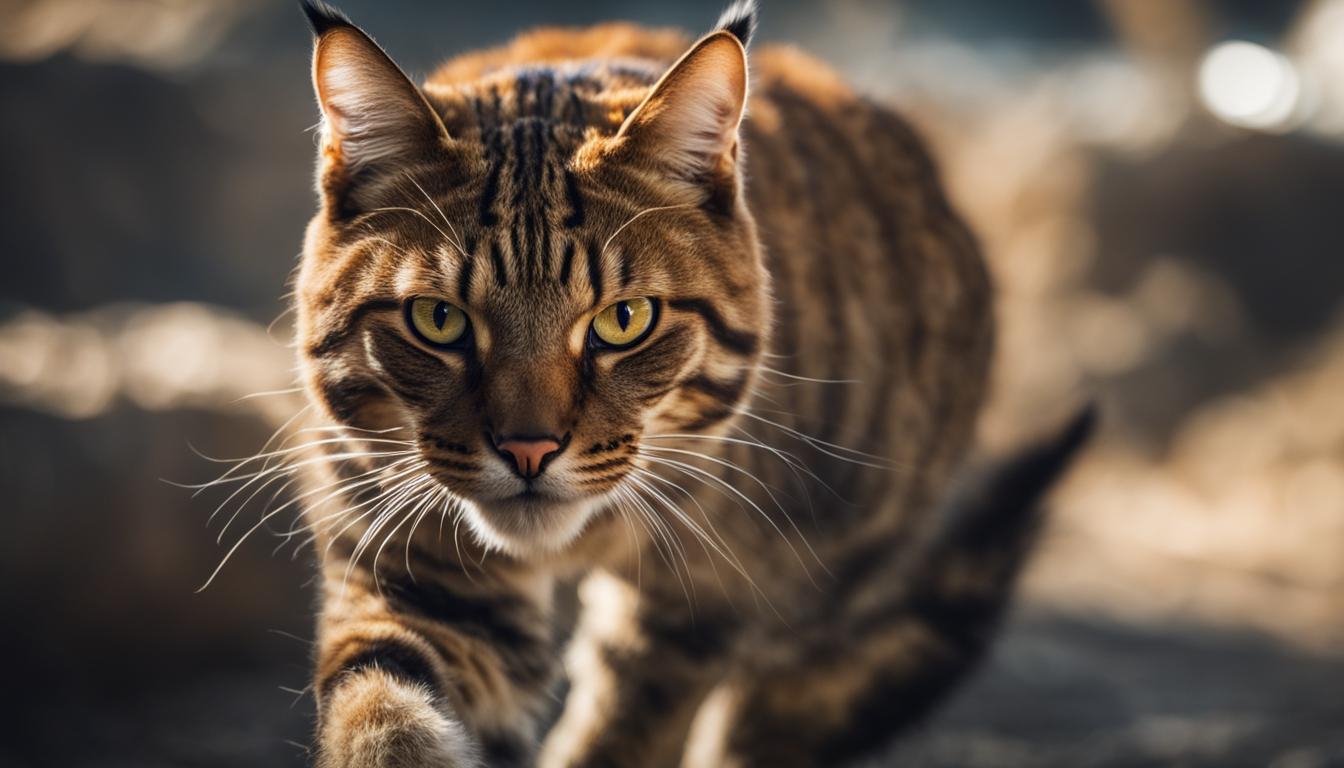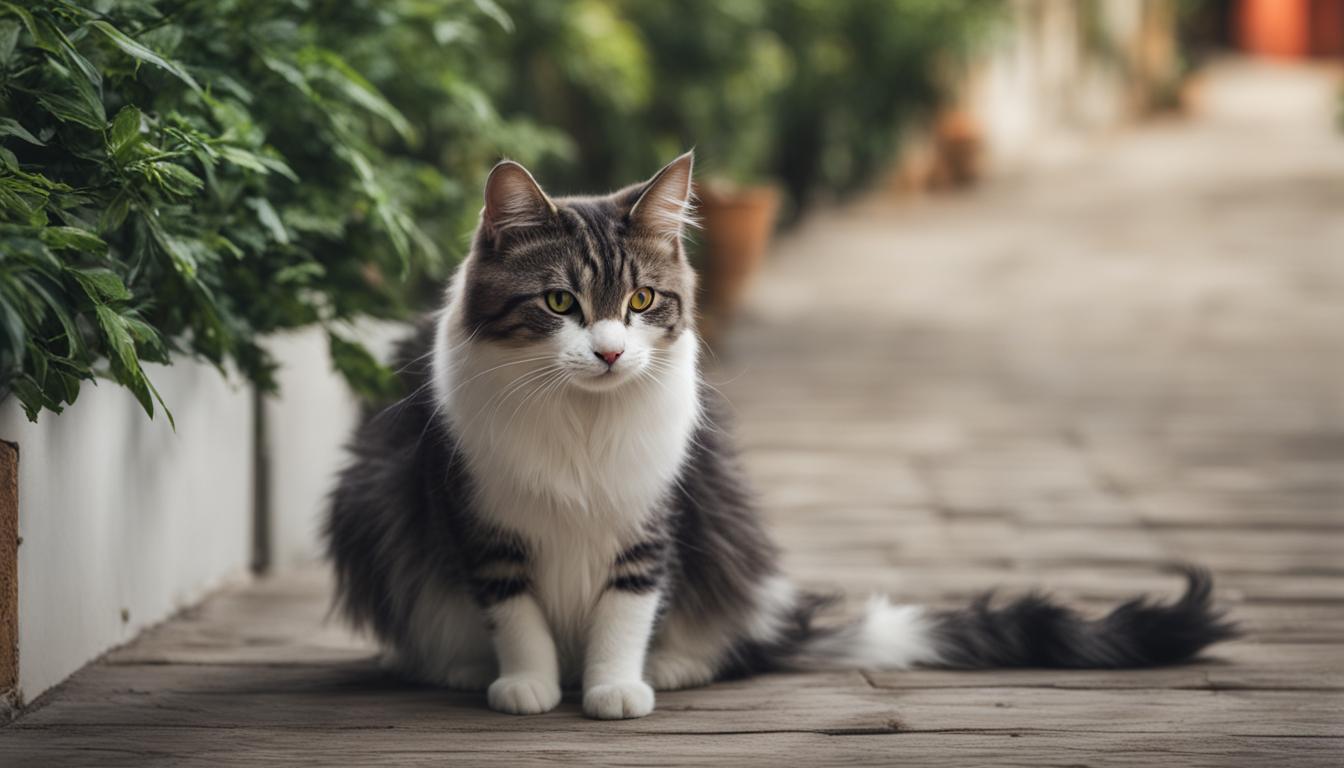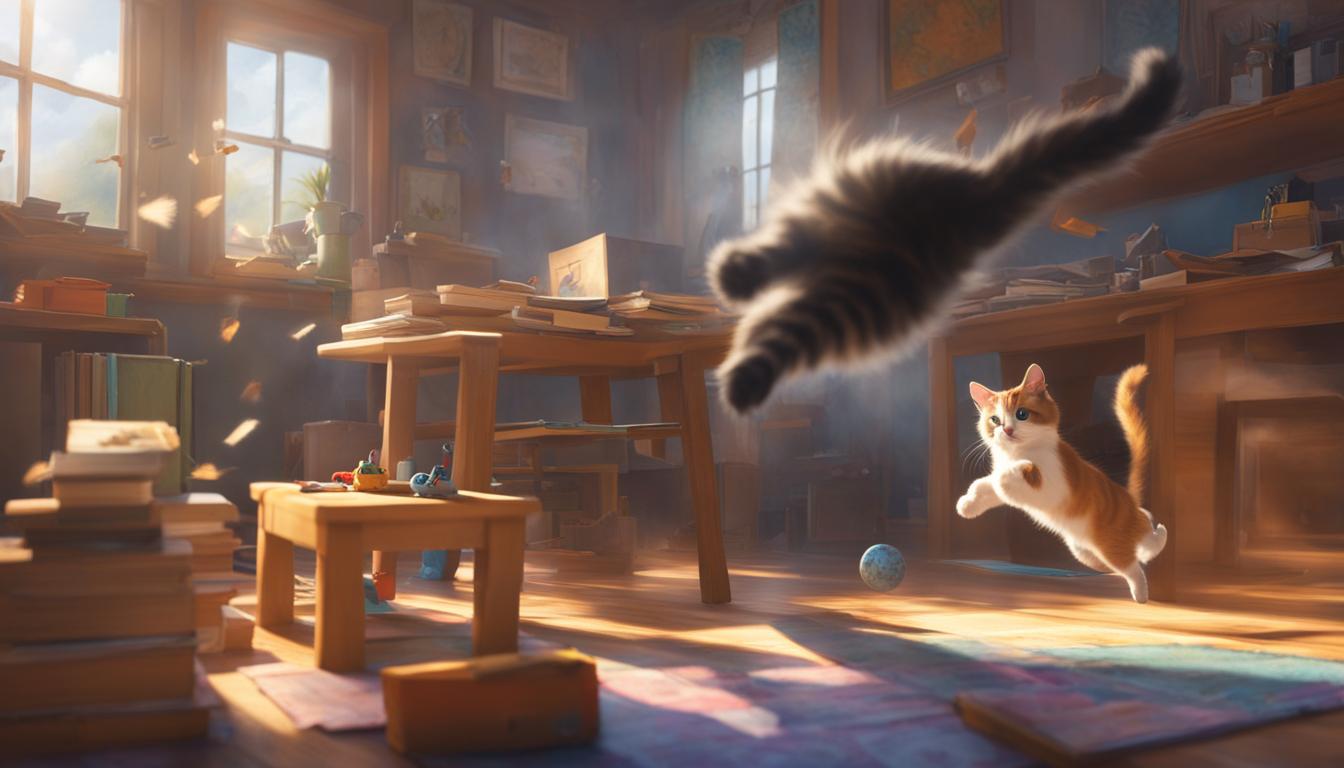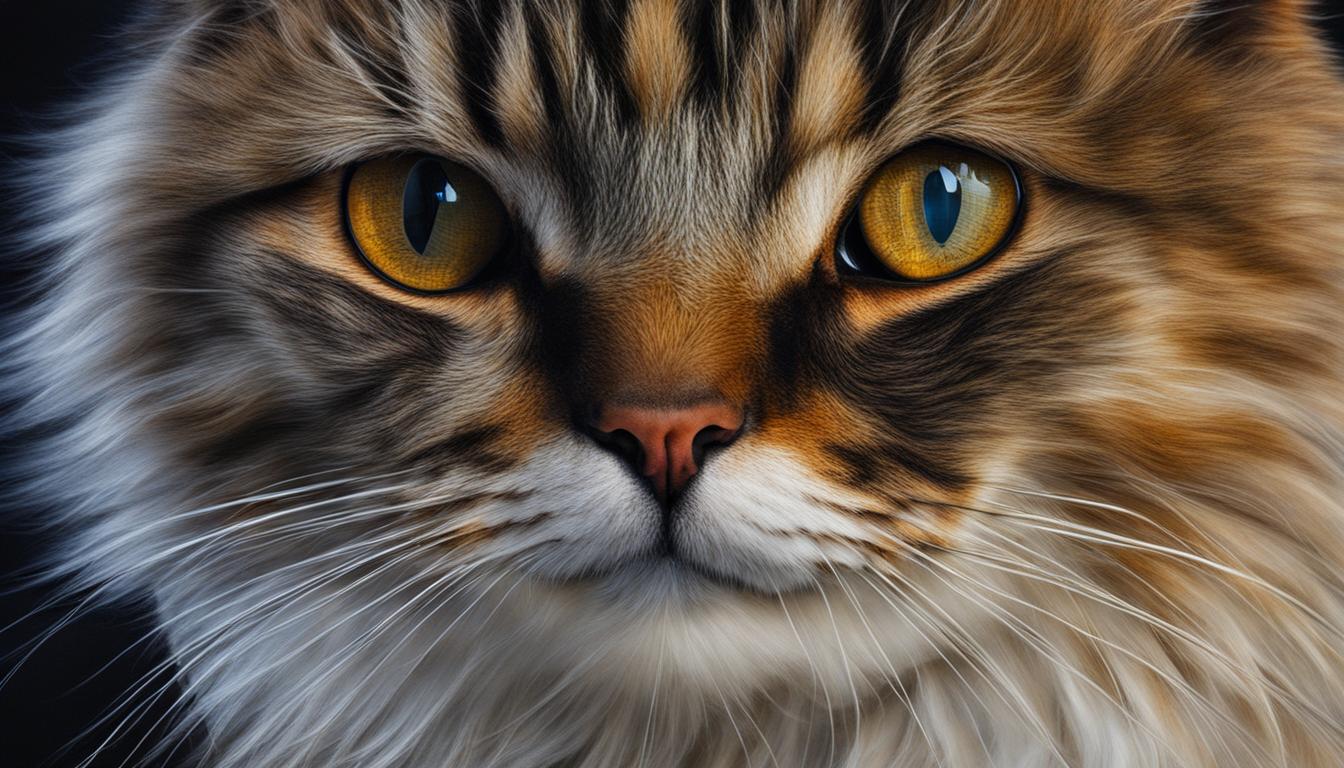Meow! Have you ever wondered why your fluffy feline friend stalks its toys or pounces on unsuspecting objects? Well, let me take you on a fascinating journey into the world of cat hunting instincts. As obligate carnivores, cats have inherited their wild ancestors’ primal hunting behaviors, even if they have a cozy home and are well-fed by their human companions. It’s in their DNA to engage in these instinctual behaviors, and understanding them is key to providing a fulfilling life for our beloved furballs.
So, what exactly drives our cats to exhibit predatory behavior, even when they have no intention of consuming their “catch”? Let’s dive into the fascinating world of cat stalking behavior and find out how we can nurture their hunting instincts while keeping harmony in our homes.
Key Takeaways:
- Cats have retained their hunting instincts from their wild ancestors, even as domesticated pets.
- Hunger is only part of the motivation for hunting; cats are opportunistic hunters and may engage in playful hunting behavior regardless of their satiety.
- Understanding the sequence of hunting behaviors, such as stalking, sprinting, and pouncing, helps us comprehend our cats’ natural instincts.
- Managing cat hunting instincts can be challenging but achievable through interactive play sessions and feeding strategies.
- Respecting cats’ natural instincts while minimizing the impact on both their well-being and the environment is crucial for responsible cat ownership.
Cat Hunting Techniques and Play Behavior
Cats have developed a range of impressive hunting techniques that allow them to capture prey with precision and agility. These techniques closely mimic the behaviors of their wild counterparts and can also be observed during play sessions. By understanding these techniques and incorporating interactive play into their daily routine, cat owners can help train their feline companions to hone their hunting skills in a controlled environment.
One of the most common hunting techniques cats employ is stalking. They carefully observe their prey, crouching low to the ground and moving with calculated stealth. This behavior can be redirected through play by using feather teasers or moving toys that mimic the movements of small animals. By engaging their cats in interactive play sessions, owners can stimulate their hunting instincts and provide an outlet for their natural predatory drive.
In addition to stalking, cats also exhibit sprinting and pouncing behaviors when hunting. These rapid bursts of energy allow them to close in on their prey swiftly and efficiently. Play sessions that involve toys that encourage chasing and quick movements can help cats develop their sprinting and pouncing skills. This type of play not only provides mental stimulation but also helps fulfill their instinctual need for physical activity.
| Cat Hunting Techniques | Play Behavior |
|---|---|
| Stalking | Feather teasers |
| Sprinting | Toys that encourage chasing |
| Pouncing | Toys that mimic quick movements |
Training a cat’s hunting skills through play not only helps them satisfy their natural instincts but also provides various benefits. It promotes physical exercise, mental stimulation, and the development of coordination and agility. Additionally, engaging in play activities with cats strengthens the bond between cats and their owners, creating a positive and enriching environment for both.
Managing Cat Hunting Instincts in the Home
Cat owners often find themselves dealing with the challenge of managing their cats’ hunting instincts within the home. While cats are natural hunters, there are ways to provide alternative outlets for their hunting behavior and encourage healthier hunting habits. By understanding and addressing their instinctual needs, cat owners can create a harmonious living environment for both their feline companions and themselves.
Feeding Strategies
One effective way to manage cat hunting instincts is through a feeding strategy that mimics their natural prey drive. Instead of feeding cats one or two large meals a day, consider offering smaller, more frequent meals throughout the day and night. This approach not only satisfies their nutritional requirements but also provides mental stimulation and reduces the motivation to hunt for food.
It’s important to choose a highly palatable cat food with a high meat content to ensure your cat’s dietary needs are met. Cats are obligate carnivores, and a diet rich in animal protein is essential for their overall health and wellbeing. By providing a nutritionally balanced diet, you can help curb their hunting instincts driven by hunger.
Interactive Play Sessions
Another effective strategy for managing cat hunting instincts is through interactive play sessions that simulate hunting behavior. Engaging your cat in play with toys that resemble prey items can redirect their hunting instincts and provide a safe and controlled environment for them to fulfill their natural desires. Feather teasers, laser pointers, and interactive puzzle toys are great options to stimulate their hunting instincts.
Regular play sessions not only help satisfy their hunting desires but also provide mental and physical exercise. Play sessions should be interactive, allowing your cat to stalk, chase, and pounce on the toy. Remember to vary the play patterns and use different types of toys to keep their interest and provide a diverse hunting experience.
Environmental Enrichment
Creating an enriched environment for your cat can also help manage their hunting instincts. Provide plenty of vertical spaces, such as cat trees or shelves, where they can climb and observe their surroundings. This allows them to engage in natural behaviors like perching and surveying potential prey. Window perches or bird feeders outside can provide additional visual stimulation.
Introducing puzzle feeders or hiding treats around the house can also engage their hunting instincts. This type of environmental enrichment encourages them to use their senses and problem-solving skills, diverting their attention from hunting live prey.
The Relationship Between Play and Predation
Cats have an innate hunting instinct that drives their predatory behavior. When cats engage in play, they often exhibit behaviors that closely resemble their hunting techniques. This connection between play and predation is significant for cat owners to understand, as it can help provide appropriate outlets for their cats’ natural instincts and reduce unwanted hunting behaviors.
One interesting behavior that cats display during play is “toying” with their prey. After catching their target, cats may engage in playful behavior, such as batting or tossing the prey around. This behavior serves as a displacement activity, allowing cats to manage the conflict between their instinct to kill and the fear of potential injury. It’s a fascinating insight into the complex nature of a cat’s predatory drive.
“Toying” behavior is thought to help cats practice and refine their hunting skills while also providing an opportunity to release any pent-up energy. This behavior is more commonly observed in adult cats, particularly when they are hungry and motivated to hunt. It reinforces the notion that cats perceive play as a simulated hunting experience, even with toys that resemble prey items.
The relationship between play and predation is an important consideration for cat owners seeking to manage their cats’ hunting instincts. By providing interactive toys that mimic prey and engaging in regular play sessions, owners can redirect their cats’ hunting behaviors in a safe and controlled manner. This not only helps satisfy their cats’ natural instincts but also provides mental stimulation and enrichment, leading to happier and healthier feline companions.

The Relationship Between Play and Predation
Cats have an innate hunting instinct that drives their predatory behavior. When cats engage in play, they often exhibit behaviors that closely resemble their hunting techniques. This connection between play and predation is significant for cat owners to understand, as it can help provide appropriate outlets for their cats’ natural instincts and reduce unwanted hunting behaviors.
One interesting behavior that cats display during play is “toying” with their prey. After catching their target, cats may engage in playful behavior, such as batting or tossing the prey around. This behavior serves as a displacement activity, allowing cats to manage the conflict between their instinct to kill and the fear of potential injury. It’s a fascinating insight into the complex nature of a cat’s predatory drive.
“Toying” behavior is thought to help cats practice and refine their hunting skills while also providing an opportunity to release any pent-up energy. This behavior is more commonly observed in adult cats, particularly when they are hungry and motivated to hunt. It reinforces the notion that cats perceive play as a simulated hunting experience, even with toys that resemble prey items.
The relationship between play and predation is an important consideration for cat owners seeking to manage their cats’ hunting instincts. By providing interactive toys that mimic prey and engaging in regular play sessions, owners can redirect their cats’ hunting behaviors in a safe and controlled manner. This not only helps satisfy their cats’ natural instincts but also provides mental stimulation and enrichment, leading to happier and healthier feline companions.
| Play and Predation | Toying Behavior |
|---|---|
| Cats exhibit hunting behaviors during play. | “Toying” behavior is a displacement activity that helps cats manage the conflict between the instinct to kill and fear of injury. |
| Play allows cats to practice hunting skills and release pent-up energy. | “Toying” behavior is more commonly observed in hungry adult cats, reinforcing the perception of play as a simulated hunting experience. |
| Engaging in play with interactive toys helps redirect cats’ hunting instincts in a safe and controlled manner. | Understanding the relationship between play and predation encourages appropriate outlets for cats’ natural instincts and reduces unwanted hunting behaviors. |
Strategies to Discourage Cat Hunting
Understanding cat stalking behavior and managing cat hunting instincts are crucial tasks for cat owners. Here are some effective strategies to discourage hunting behavior in cats:
- Redirect Hunting Instincts Through Play: Engaging cats in interactive play sessions can help redirect their hunting instincts. Use toys that mimic prey and encourage stalking, sprinting, and pouncing behaviors. By providing a controlled environment for play, you can satisfy your cat’s natural prey drive while avoiding unwanted hunting in the home.
- Provide a Balanced Diet: Feeding cats a nutritious diet that meets their nutritional needs can help reduce hunting driven by hunger. A high-quality cat food with a high meat content is recommended. By ensuring your cat is well-fed, you can minimize their motivation to hunt for food.
- Use Collars with Bells: Adding a collar with bells to your cat can help deter hunting behavior. The sound of the bells alerts potential prey to the cat’s presence, giving them a chance to escape. However, it’s important to choose a collar that is safe and comfortable for your cat to wear.
- Limit Outdoor Access During Active Prey Times: Cats should be kept indoors during times when prey species are most active, such as dawn and dusk. This reduces the opportunities for successful hunts and helps minimize the impact on local wildlife populations.
Remember, punishment should never be used to discourage hunting behavior in cats as it is a natural instinct. Instead, focus on providing alternative outlets for their hunting instincts through play and environmental enrichment. With these strategies, you can help your cat fulfill their hunting desires in a healthy and controlled manner.
| Strategy | Description |
|---|---|
| Redirect Hunting Instincts Through Play | Engage cats in interactive play sessions using prey-like toys |
| Provide a Balanced Diet | Feed cats a nutritious diet with a high meat content |
| Use Collars with Bells | Add a collar with bells to deter hunting behavior |
| Limit Outdoor Access During Active Prey Times | Keep cats indoors during dawn and dusk when prey is active |
Implementing these strategies can help you manage your cat’s hunting instincts and create a harmonious environment both for your cat and the local wildlife.

Conclusion
Understanding cat stalking behavior and managing their hunting instincts is crucial for cat owners. Cats are natural-born hunters, and it’s important to provide them with appropriate outlets for their hunting behaviors while keeping their safety and the environment in mind.
By encouraging healthy hunting behavior in cats, we can strike a balance between allowing them to express their natural instincts and minimizing the impact on both their well-being and the local wildlife. This can be achieved through interactive play sessions that redirect their hunting instincts and provide mental stimulation.
Additionally, offering a highly palatable diet that mimics their natural feeding pattern can help satisfy their prey drive and reduce hunting driven by hunger. Remember, punishment should never be used to discourage hunting behavior, as it is an innate instinct for cats.
With a thoughtful approach and understanding of cat stalking behavior, we can create a harmonious environment where our feline friends can thrive and exhibit their natural hunting instincts in a way that benefits both them and their surroundings.
FAQ
Do domestic cats still have hunting instincts?
Yes, domestic cats have retained their hunting instincts from their wild ancestors.
Why do cats engage in hunting behavior even when they are fed?
Cats have an innate need to hunt for their food, as they are obligate carnivores.
What sequence of behaviors do cats exhibit when hunting?
Cats commonly follow a set sequence of behaviors when hunting, including stalking, sprinting, and pouncing.
Is hunger the only motivation for cats to hunt?
Hunger is only partially related to their motivation to hunt; cats are opportunistic and will take advantage of any hunting opportunities that arise.
Why do cats bring home prey they have caught?
Owned cats may bring home prey as a form of play, even if they do not intend to kill or consume it.
How can owners encourage their cats’ hunting skills?
Owners can encourage their cats’ hunting skills through interactive play sessions using feather teasers or moving toys.
Why is play important for indoor cats?
Play allows indoor cats to fulfill their hunting instincts in a controlled environment and provides mental stimulation.
How can cat owners manage hunting instincts in the home?
Providing a highly palatable cat food, feeding small, frequent meals throughout the day, and increasing the frequency of play sessions can help reduce hunting behavior.
What is toying behavior in cats?
Toying behavior is when cats engage in play behavior with their prey after catching it, helping them manage the conflict between the instinct to kill and the fear of potential injury.
What strategies can be used to discourage hunting behavior in cats?
Redirecting hunting instincts through play, feeding a nutritious diet, using collars with bells, and keeping cats indoors during high activity times for prey species can help discourage hunting behavior.
Can hunting behavior in cats be completely eliminated?
Hunting instincts are deeply ingrained in cats’ nature, but with appropriate management, unwanted hunting behavior can be minimized.





